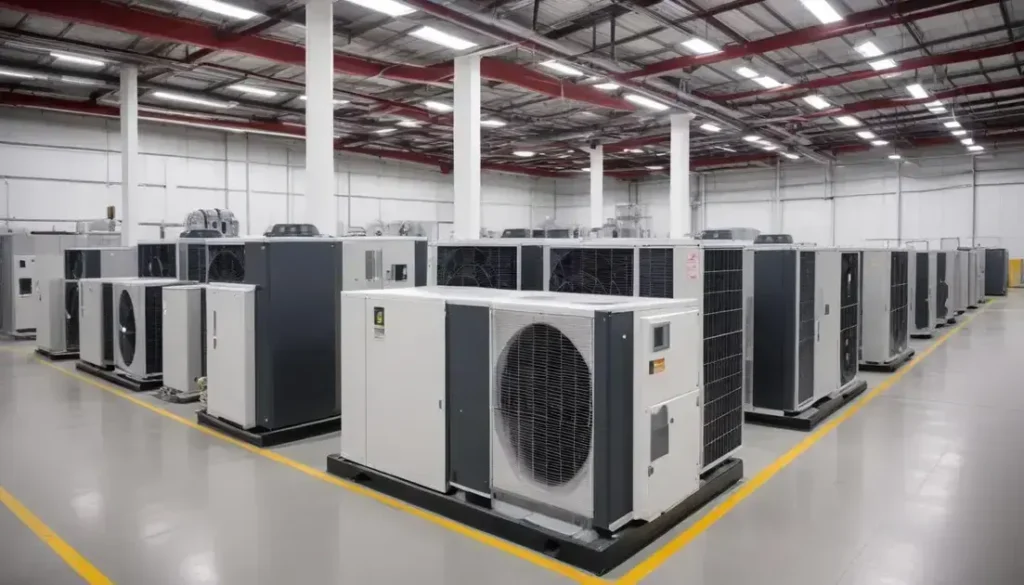Applied Materials enhances sustainability in the Asia-Pacific region through collaboration, renewable energy adoption, and technological innovations, aiming for net-zero emissions and improved efficiencies across various industries.
In the realm of sustainability, **Applied Materials** is making significant strides. Their recent Impact Report highlights key advancements that could reshape opportunities for Australian businesses in the tech sector. Are you ready to explore these possibilities?
Introduction to Applied Materials and sustainability
Applied Materials is at the forefront of sustainability in the tech industry, actively developing solutions that enhance energy efficiency in semiconductor manufacturing. The company’s initiative aims to reduce its carbon footprint through innovative processes that minimise resource consumption. By integrating renewable energy sources across its facilities, Applied Materials is setting a standard for others in the sector to follow.
Through its 2024 Impact Report, Applied Materials highlights its commitment to achieving significant reductions in both Scope 1 and Scope 2 emissions. This strategic focus on sustainability not only benefits the environment but also enables businesses to align with global sustainability standards. The company emphasises collaboration with suppliers to foster a sustainable supply chain, encouraging the adoption of environmentally friendly practices throughout the industry.
Moreover, the report outlines how Applied Materials leverages artificial intelligence to monitor energy usage and enhance operational efficiency. By harnessing AI technologies, the company can identify areas for improvement and implement solutions that lead to substantial energy savings. This forward-thinking approach not only positions Applied Materials as a leader in sustainability but also provides valuable insights applicable to Australian businesses aiming to enhance their own strategies.
Overview of the 2024 Impact Report
The 2024 Impact Report from Applied Materials showcases the company’s dedication to achieving sustainability goals while driving innovation in semiconductor technology. It highlights the significant strides made towards reducing greenhouse gas emissions across global operations. By setting clear targets, the report underlines the importance of sustainability within their corporate strategy.
This year, the company reports a substantial decrease in energy consumption through enhanced manufacturing processes. These improvements not only minimise environmental impact, but also contribute to cost efficiency for the organisation. Applied Materials is implementing a robust framework to track and report its energy use, ensuring transparency and accountability.
A key focus of the report is the engagement with stakeholders to cultivate a culture of sustainability. Partnerships with suppliers are essential for achieving comprehensive emissions reductions across the supply chain. The report discusses initiatives aimed at fostering collaboration, encouraging suppliers to adopt sustainable practices as well.
Moreover, the report emphasises the role of innovation, such as the use of advanced technologies in production. By investing in research and development, Applied Materials continues to lead the way in creating sustainable solutions that meet the evolving demands of the market. This forward-thinking approach not only positions them as industry leaders but also inspires other companies to follow suit.
Goals for renewable energy usage
Applied Materials has set ambitious goals for renewable energy usage as part of its comprehensive sustainability strategy. The company aims to transition towards 100% renewable energy across its global operations by 2030. This target reflects a commitment not just to compliance with environmental standards but also to leadership in the tech industry.
To achieve this, Applied Materials is investing heavily in solar and wind energy. By partnering with renewable energy providers, the company seeks to secure sustainable energy sources that meet its operational needs. This transition is vital for reducing greenhouse gas emissions and minimising the environmental impact of its manufacturing processes.
In addition to sourcing renewable energy, Applied Materials is enhancing energy efficiency by upgrading its facilities with cutting-edge technology. By implementing advanced energy management systems, the company can monitor and optimise energy consumption in real-time. This focus on efficiency not only supports the environmental goals but also results in significant cost savings.
The open collaboration with suppliers is a crucial part of this strategy. Applied Materials encourages its suppliers to adopt similar renewable energy practices, creating a ripple effect throughout the supply chain. This approach not only strengthens the company’s sustainability goals but also aligns with the broader industry movement towards a greener future.
Current energy sources in facilities
Applied Materials utilises a diverse range of energy sources in its facilities to power its extensive manufacturing processes. Currently, the company is transitioning from traditional energy sources to more sustainable options, aiming to reduce its overall environmental impact. This shift includes a significant reliance on natural gas, which serves as a cleaner alternative to coal and oil.
The integration of renewable energy sources is also being increased, with investments in solar and wind power generating a portion of the electricity used in its facilities. By harnessing these clean sources, Applied Materials not only decreases its carbon footprint but also enhances energy security and cost efficiency.
In 2024, the company plans to further expand its use of renewable energy, targeting a greater share of its energy mix. This strategy includes engaging with local utility providers to support the development of renewable energy infrastructures. Additionally, energy-efficient technologies are being implemented within the facilities to minimise consumption and maximise output.
Monitoring energy usage is critical, and Applied Materials employs advanced energy management systems. These systems provide real-time data analytics, enabling the company to optimise energy consumption across its operations. This comprehensive approach enhances operational efficiency while actively contributing to sustainability goals.
Scope 1 and 2 emissions targets
Applied Materials is committed to reducing its Scope 1 and 2 emissions as part of its broader sustainability initiatives. Scope 1 emissions are direct greenhouse gas emissions from owned or controlled sources, while Scope 2 emissions encompass indirect emissions from the generation of purchased energy. The company has set ambitious targets to cut these emissions significantly by 2030.
The strategy includes transitioning to renewable energy sources across all operational facilities. By investing in solar and wind energy, Applied Materials aims to eliminate reliance on fossil fuels, thus directly reducing its carbon output. Furthermore, energy efficiency measures are being implemented to minimise electricity consumption without compromising production capabilities.
Applied Materials employs advanced monitoring systems to track emissions in real-time. This data-driven approach enables the company to assess its progress toward meeting its targets and identify areas for improvement. Regular audits and sustainability assessments ensure compliance with environmental regulations and internal goals.
Collaboration with suppliers is a critical element of this strategy. By encouraging suppliers to adopt similar strategies for emissions reduction, Applied Materials extends its impact beyond its operations, creating a more sustainable supply chain. This collaborative approach is vital for achieving long-term sustainability and demonstrates the company’s leadership in environmental responsibility.
Achievements in Scope 3 emissions reduction
Applied Materials has made significant strides in reducing Scope 3 emissions, which are indirect greenhouse gas emissions that occur in the value chain, including both upstream and downstream activities. This focus on Scope 3 is vital, as these emissions often represent the largest portion of a company’s carbon footprint.
The company has implemented targeted initiatives aimed at engaging suppliers and customers in sustainability efforts. By encouraging suppliers to adopt greener practices, Applied Materials is fostering a collaborative environment focused on emission reductions throughout the supply chain. This includes promoting the use of renewable energy sources and energy-efficient technologies among suppliers.
Moreover, Applied Materials conducts regular assessments to identify areas where emissions can be reduced. Initiatives range from optimising logistics to minimise transportation emissions to implementing circular economy practices that reduce waste and enhance resource efficiency. These strategies are not only beneficial for reducing carbon output but also help in driving innovation and economic savings.
Engagement with customers is equally important, as Applied Materials works to support them in reducing their own emissions. By providing solutions that enhance energy efficiency and sustainability, the company plays a pivotal role in helping its partners achieve their environmental goals.
Highlights of energy efficiency improvements
Applied Materials has achieved remarkable energy efficiency improvements that significantly enhance its operational sustainability. These advancements are a testament to the company’s dedication to reducing its environmental footprint while maintaining high production standards. Key initiatives have been implemented across various facilities to optimise energy consumption and minimise waste.
By utilising advanced technologies, Applied Materials has transformed its manufacturing processes. This includes the integration of energy-efficient machinery and automation systems that significantly lower energy use while boosting output. Real-time monitoring systems help track energy consumption, allowing for immediate adjustments to enhance efficiency.
Another major highlight involves the retrofitting of existing equipment with energy-saving capabilities. This strategic move has led to substantial reductions in energy consumption, cutting costs and emissions without the need for complete overhauls. The focus on smart energy management ensures that facilities operate at peak efficiency, further contributing to the company’s sustainability goals.
Collaboration with energy providers is also essential in achieving these improvements. By negotiating contracts that favour renewable energy sourcing, Applied Materials is ensuring that its operations are powered by clean energy, further supporting its commitment to sustainability.
Engagement with suppliers on sustainability
Applied Materials prioritises engagement with suppliers as a cornerstone of its sustainability strategy. Recognising that approximately 70% of a company’s emissions can stem from its supply chain, Applied has taken significant steps to involve suppliers in environmental initiatives. This approach is essential for driving widespread emissions reductions.
The company actively collaborates with suppliers to promote sustainable practices, urging them to adopt energy-efficient technologies and renewable energy sources. By providing training and resources, Applied Materials ensures that its suppliers understand and can implement best practices in sustainability.
One of the initiatives includes conducting sustainability assessments for suppliers, which helps identify areas for improvement and sets clear performance expectations. This collaborative effort fosters a sense of accountability and encourages suppliers to innovate towards greener solutions. Furthermore, Applied Materials establishes long-term partnerships with those who demonstrate commitment to sustainability, ensuring mutual benefits in terms of efficiency and compliance.
Engaging with suppliers also involves sharing technological advancements that can bolster sustainability efforts. By working closely with its supply chain, Applied Materials not only enhances its own sustainability profile but also contributes to a broader movement towards environmentally responsible industry practices.
The role of artificial intelligence in sustainability
Artificial intelligence (AI) is playing a transformative role in enhancing sustainability across various industries, including semiconductor manufacturing. Applied Materials harnesses AI to optimise processes, reducing waste and energy consumption while increasing efficiency. By analysing large datasets, AI identifies patterns that inform better decision-making and operational strategies.
One of the key applications of AI is in energy management. AI systems can predict energy needs and adjust usage dynamically, ensuring that facilities operate at peak efficiency. This not only minimises energy costs but also supports the company’s sustainability targets by reducing carbon emissions.
In addition to energy management, AI helps in resource allocation by streamlining supply chain operations. Predictive analytics can forecast demand more accurately, leading to reduced overproduction and waste. This proactive approach promotes a circular economy and enhances resource efficiency.
Moreover, AI-driven technologies enable real-time monitoring and reporting of sustainability metrics. This allows Applied Materials to track progress toward its environmental goals more effectively. With AI’s capability to analyse complex data, the company can refine its sustainability initiatives continuously, making informed adjustments based on performance insights.
Future strategies for decarbonisation
Applied Materials is paving the way for future strategies aimed at decarbonisation through innovative approaches that combine technology and sustainability. The overarching goal is to achieve net-zero emissions across all operations by 2030, a target set to address the urgent need for environmental responsibility in the tech sector.
Central to this strategy is the increased reliance on renewable energy sources. The company is committed to enhancing its energy infrastructure by investing in solar and wind power projects. These initiatives not only contribute to reducing carbon footprints but also promote energy independence and resilience.
In addition to renewable energy, Applied Materials is exploring advanced manufacturing techniques that incorporate low-carbon alternatives. This includes utilising materials that require less energy for production and emphasising the development of sustainable supply chains. Collaborating with suppliers and partners is critical to extending the impact of these advancements beyond its operations.
Moreover, the adoption of cutting-edge technologies like artificial intelligence and machine learning will enable Applied Materials to optimise energy consumption and streamline processes. By leveraging data analytics, the company can make informed decisions that drive efficiency and further reduce emissions. This proactive approach establishes a robust framework for continuous improvement in sustainability efforts.
Impact on Australian businesses and sectors
The advancements in sustainability practices by companies like Applied Materials have a profound impact on Australian businesses and sectors. As Australia moves towards a low-carbon economy, the emphasis on cutting emissions and enhancing operational efficiency becomes crucial for local industries, particularly in mining, agriculture, and manufacturing.
Australian exporters stand to benefit significantly from the adoption of sustainable technologies. By aligning with global sustainability standards, they can gain access to new markets that prioritise green practices. This shift not only enhances their reputation internationally but also provides a competitive advantage in the Asia-Pacific region.
In the mining sector, companies are increasingly investing in renewable energy solutions to power their operations. This transition reduces reliance on fossil fuels and helps meet strict environmental regulations. The use of clean technology not only lowers operational costs but also contributes positively to the environment, enhancing community relations.
Furthermore, the agricultural sector can leverage sustainable practices to improve productivity and reduce environmental impact. Implementing energy-efficient processes and renewable energy can help farmers lower costs and produce more sustainably, directly benefiting the local economy and consumers.
Collaboration in the Asia-Pacific region
Collaboration in the Asia-Pacific region is crucial for driving sustainability efforts across diverse sectors. Applied Materials exemplifies this through partnerships with various stakeholders in the region, fostering innovation and sharing best practices that benefit the entire supply chain. By working together, companies can enhance their operational efficiencies while also addressing environmental challenges.
One major aspect of this collaboration involves sharing technological advancements aimed at reducing carbon emissions. By pooling resources and knowledge, partner companies can implement solutions that not only meet local regulations but also align with global sustainability standards. This strategy creates opportunities for cross-border projects that amplify impact.
The region’s diverse economic landscape allows for tailored approaches in different sectors, such as mining, agriculture, and manufacturing. For example, mining companies may focus on optimising energy use through renewable sources, while agricultural partners adopt water-efficient practices. Each collaboration helps to build a more sustainable future, addressing specific local challenges.
Furthermore, initiatives within this collaborative framework open channels for dialogue among governments, businesses, and communities. This dialogue facilitates alignment on objectives and priorities, fostering a united front in the pursuit of sustainability goals. As these partnerships evolve, they will play an essential role in shaping a greener, more sustainable Asia-Pacific region.
Conclusion and outlook on sustainability efforts
The ongoing efforts towards sustainability are gaining momentum across various industries, as companies like Applied Materials lead the way in implementing advanced environmental practices. With strong commitments to reducing emissions and enhancing operational efficiency, the outlook for sustainability remains optimistic.
As businesses focus on embracing renewable energy sources and innovative technologies, the potential for substantial environmental impact increases. Companies are not only meeting regulatory requirements but are also positioning themselves as leaders in the market by adopting sustainable practices that resonate with consumers.
Collaboration among stakeholders in the Asia-Pacific region further strengthens these efforts. By sharing knowledge and resources, businesses can tackle sustainability challenges more effectively. This collective approach enables a holistic view of sustainability, allowing for tailored solutions that consider local and global impacts.
Looking ahead, the continual integration of artificial intelligence and data analytics into sustainability strategies will play a pivotal role in optimising processes and achieving long-term goals. As industries advance, the transition towards a greener economy is not just a trend but a necessity for future growth.
In Conclusion, the Path Towards Sustainability
The journey towards sustainability is essential for businesses today, with significant benefits for the environment and society. Companies like Applied Materials demonstrate that by adopting eco-friendly practices, organisations can reduce their carbon footprint and enhance efficiency.
Collaboration in the Asia-Pacific region strengthens these efforts, highlighting the power of working together for a common goal. As industries invest in renewable energy and innovative technologies, the future looks promising for sustainable development.
By integrating artificial intelligence and data analysis, businesses can optimise their sustainability strategies, ensuring that they not only meet immediate goals but also contribute to a greener future. Embracing these changes will lead to growth and create a positive impact on the planet.
Hence, it is crucial for all sectors to commit to sustainability, making it a priority for growth and success.
Frequently Asked Questions
What are the key strategies for achieving sustainability in businesses?
Key strategies include adopting renewable energy sources, improving energy efficiency, and fostering collaboration across the supply chain to reduce overall emissions.
How does collaboration in the Asia-Pacific region enhance sustainability efforts?
Collaboration allows businesses to share best practices and resources, enabling a more unified approach to tackling environmental challenges and achieving sustainability goals.
What role does artificial intelligence play in sustainability?
Artificial intelligence helps optimise processes, manage energy consumption, and analyse data to improve sustainability outcomes, making operations more efficient.
Why is supplier engagement important for sustainability?
Engaging suppliers in sustainability initiatives helps to extend eco-friendly practices throughout the supply chain, driving collective reductions in carbon emissions.
How can Australian businesses benefit from focusing on sustainable practices?
By adopting sustainable practices, Australian businesses can enhance their market reputation, gain access to new markets, and reduce costs through improved efficiencies.
What can we expect for the future of sustainability in industries?
The future of sustainability looks promising, with continued advancements in technology and greater collaboration, leading to innovative solutions and a lower carbon footprint.


